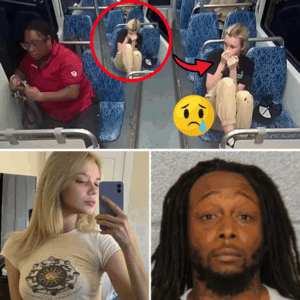In the flickering glow of a late-night light rail car, where the hum of urban fatigue drowns out the whispers of danger, Iryna Zarutska had just enough time to grasp the unimaginable. The blade’s bite was swift, three merciless thrusts from behind—into her back, her neck—turning a routine commute into a descent into hell. Blood surged, hot and unrelenting, as her body betrayed her, crumpling to the floor in a pool of crimson that spread like an accusation. In those fleeting seconds, as life ebbed from her 23-year-old frame, she turned her head to the right, her eyes—wide with shock, pleading for salvation—scanning the faces around her. What she found wasn’t heroism; it wasn’t even humanity. It was complete apathy. Strangers stared, frozen in a tableau of indifference, their silence a final, devastating blow. Iryna died alone that night on the Lynx Blue Line in Charlotte, North Carolina, not just from the knife, but from the soul-crushing realization that no one cared.

August 22, 2025, started like any other shift for Iryna, the Ukrainian refugee whose laughter had become the soundtrack of Zepeddie’s Pizzeria. Her khaki pants and dark shirt, dusted with flour from dough-tossing and cheese-grating, marked the end of another hard-earned day. At 9:50 p.m., she boarded the train at Scaleybark station in Charlotte’s South End, a neighborhood reborn from industrial grit into trendy lofts and craft breweries, all thanks to the very rail line that would claim her. She chose an empty row, tucking her long blonde hair under her work hat, her phone a small anchor in her hand as she scrolled, perhaps dreaming of the veterinary assistant job she chased or the art classes at Rowan-Cabarrus Community College where her sketches bloomed like wildflowers.
Behind her sat Decarlos Brown Jr., 34, a shadow in a red hoodie, his life a wreckage of 14 arrests stretching back to 2007—armed robberies, felony larcenies, break-ins, all laced with untreated mental illness that the system had cycled through like a broken carousel. Four minutes ticked by in deceptive peace, the train rumbling toward home. Then, without warning, without words, Brown drew a pocketknife from his hoodie and struck. The first blow pierced her back; the second and third found her neck, severing vessels in a spray of finality. Surveillance cameras, cold and unblinking, captured it all: Iryna’s body twisting in agony, her gasp slicing the air as she collapsed. For one minute and thirty-five seconds, she lay there, bleeding out on the grimy floor, her breaths shallow and ragged. In that eternal sliver of time, she managed to turn her head, her gaze sweeping rightward to the passengers mere feet away. Eyes met eyes—hers desperate, theirs vacant. No hands reached out. No voices cried for help. One man knelt briefly, but instead of aid, he pulled out his phone, filming the horror as if it were spectacle, not suffering. The train operator, following protocol, held the car still, but no one moved to staunch the flow or cradle her fading warmth. Iryna’s last conscious moments weren’t filled with family memories or unfulfilled dreams; they were haunted by the apathy of those who could have been her lifeline.
Bystander apathy isn’t new—psychologists have dissected it since the 1968 Kitty Genovese case, where 38 witnesses watched a woman murdered without intervening, a phenomenon rooted in diffusion of responsibility: “Someone else will act.” But in Iryna’s case, the betrayal cuts deeper, amplified by the digital permanence of the footage. Released by the Charlotte Area Transit System on September 5, 2025, the video exploded across screens, not as a call to action but as a mirror to society’s fractured soul. Viewers recoiled at the stillness: a car full of able-bodied adults, heads bowed to devices or averted in denial, as a young woman’s life pooled around her. “She looked right at them,” one viral post lamented, echoing the raw footage where Iryna’s eyes, glassy with encroaching death, sought connection and found none. Experts on platforms like X debated the medical odds—a neck wound like hers, likely severing the carotid, offered slim survival chances even with instant intervention, per trauma data from the American College of Surgeons. But that’s not the point. The point is the isolation, the dying alone with the weight of uncaring stares, a feeling that no CPR could revive.
Iryna’s story didn’t begin in blood; it was forged in firebombs and farewell. Born May 22, 2002, in Kyiv, she was an artist whose hands restored faded beauties and sketched dreams into reality. A Synergy College graduate in art and restoration, she gifted portraits that captured souls, her passion extending to animals—she walked neighborhood dogs with a radiant smile, her obituary later read, aspiring to veterinary work. When Russian tanks rolled in on February 24, 2022, her world shattered. The Zarutskas—mother, Iryna, sister, and brother—huddled in a bomb shelter under their apartment for months, emerging only amid wailing sirens. Her father stayed behind, conscripted by Ukraine’s laws barring men from fleeing, their goodbyes stolen across static-filled calls. In August 2022, visas whisked them to North Carolina, first to Huntersville with relatives, then to a fragile new life in Charlotte.
There, Iryna bloomed. She mastered English with voracious classes, juggled barista gigs and pizzeria shifts, her laughter drawing tips and friends alike. At community college, she sketched between lectures, weaving ties across ages—dog walks with elders, free portraits for kids. “She fell in love with the American Dream,” her uncle shared, voice cracking in interviews, “building bridges everywhere, shining like she owned the sun.” Fleeing war for safety, she found not just refuge but rebirth—until that train ride home.
The aftermath was a maelstrom. Brown was arrested on-site, charged with first-degree murder, his history a damning scroll: 14 arrests, repeated releases despite mental health red flags, the last without bail by Magistrate Judge Teresa Stokes just months prior. Federal charges followed on September 9, 2025, for causing death on mass transit, carrying death penalty potential, as the DOJ decried it an “attack on the American way of life.” Charlotte Mayor Vi Lyles called it a “tragic failure” of courts and magistrates, vowing more patrols and police on transit. President Trump sent “love and hope,” slamming “horrible” urban decay; Elon Musk amplified the video on X, fueling a firestorm on fare enforcement lapses, mental health gaps, and criminal justice revolving doors. U.S. Transportation Secretary Sean Duffy launched probes into CATS’ security failures. Yet, amid policy roars, the human core lingered: Iryna’s family, shattered in Huntersville, her father marooned in Ukraine, unable to bury his daughter. The GoFundMe swelled for repatriation, but grief swelled more.
For Iryna, that final glance to the right wasn’t just a plea; it was a judgment on us all. In her eyes, we saw our own potential for inaction—the scroll over the scream, the averted gaze over the outstretched hand. She died feeling utterly alone, uncared for, her last thought perhaps a echo of Kyiv’s shelters: Why won’t anyone help? The footage immortalizes that apathy, a viral ghost haunting feeds, sparking not just outrage but introspection. On X, threads dissected the 1:35 limbo: Could a pressure on the wound have bought time? A voice commanding aid? Medical voices whispered no—the neck’s fragility doomed her from the first slice—but the question isn’t survival; it’s solidarity.
Her death isn’t isolated; it’s indictment. A refugee who braved bombs for this—a blade in the back, eyes that wouldn’t meet hers. Yet, in death, Iryna ignites change: vigils with canvases of her art, calls for transit guardians, reckonings with systems that free predators while binding the innocent. Her family clings to memories—her sketches, her smiles, her unyielding shine—vowing to carry her voice where hers fell silent. And we, witnesses to her end, must ask: In her place, would we look away? Or finally, fiercely, care?
Iryna Zarutska didn’t just die alone; she exposed the voids we pretend aren’t there. Her last look demands we fill them—not with policies alone, but with presence. Because in the next car, the next crisis, it could be you turning right, searching for a hero. Don’t let them die feeling no one cares. Be the hand that reaches. Be the voice that breaks the silence. For Iryna, for all of us—care.


